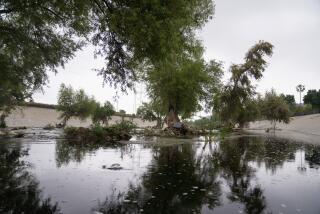A ‘Red River’ in Spain May Yield Clues to Life on the Red Planet
- Share via
ALONG THE RIO TINTO, Spain — If there is life on Mars, scientists believe it’s likely to be tiny organisms that can survive below the planet’s surface, without sunlight or oxygen, nourished by the minerals available even in that harsh environment.
In other words, thinks Ricardo Amils Pibernat, a researcher at the Center for Astrobiology in Madrid, past or present life on the red planet could well resemble the unusual microbes that populate Spain’s Rio Tinto. The 58-mile-long river, which flows through one of the world’s largest deposits of pyrite, or fool’s gold, has a pH similar to that of automobile battery acid and contains virtually no oxygen in its lower depths.
Yet a team of Spanish and American scientists linked to NASA has recently confirmed the presence in the river of an abundance of microbes that not only survive but also thrive in the extreme environment. Now the scientists hope that further study of these so-called extremophiles will prove useful in the search for life on Mars.
The Rio Tinto is special because it provides an exceptionally good environment for bacteria that live by turning fool’s gold into sulfuric acid and dissolved iron, Amils explains. The chemical processes taking place in the river use up oxygen, leaving relatively little to support more typical organisms. And photosynthesis--which gives ordinary plants energy and produces oxygen--is limited, because sunlight can hardly penetrate the water, tainted red by the iron.
Yet to the scientists’ surprise, hundreds of varieties of microbes, including yeasts, other fungi, amoebas and algae, have successfully adapted to life in the river, despite the acidity and low oxygen. These findings were published this spring in the journal Nature, in an article that focused on the unexpected diversity of Rio Tinto life.
Amils and his colleagues at NASA believe that some of these extremophiles may also live deep in the damp, acidic soil that gives rise to the river, as well as at the bottom of an acidic quarry lake near its headwaters. These environments, with high iron and low oxygen, are thought to be particularly Mars-like.
The landscape along the Rio Tinto, where scientists believe mining dates back 5,000 years, is rather otherworldly, with the iron in the soil giving it a reddish hue and with little plant life.
“If you remove the green, it looks like Mars,” Amils noted.
The Center for Astrobiology has built a yardlong, remote-controlled submarine to explore the bottom of the 200-foot-deep lake.
“This will put us near Mars ... because of the lack of oxygen,” Amils explained.
In an even more ambitious project, Amils and colleagues from the NASA Ames Research Center at Moffett Field, near San Francisco, have applied for funding to test Mars drilling equipment at the Rio Tinto. The idea is that this equipment, designed to search for underground life on a future Mars mission, would be tried out in a microbe hunt here.
Carol Stoker, a scientist at NASA Ames who is one of Amils’ key collaborators on the drilling proposal, said her interest in the Rio Tinto is primarily to search for “an underground ecosystem ... of subsurface life living off of chemical energy.”
“There are certainly organisms in the Rio Tinto that are deriving energy by chemical means, not from sunlight,” Stoker said. “Iron and sulfur are essentially the elements these organisms are taking advantage of. In order for them to do this deep underground, they’d need to be doing it anaerobically--without the presence of oxygen.”
The belief that such organisms might exist underground at the Rio Tinto “is actually a hypothesis of Ricardo Amils’,” Stoker said. “It derives from the chemical constancy along the length of the river. Basically, it’s the fact that the chemistry, wherever you sample it, is pretty much the same.... It implies that what you’re sampling is the tip of the iceberg, and the big part of the iceberg is underground.”
What Stoker and Amils hope to do is bring to the Rio Tinto area equipment designed for an unmanned Mars mission, then use it by remote control to drill about 330 feet into the soil near the Rio Tinto headwaters, Stoker said. The team would analyze samples both in ordinary labs and with equipment designed for use on Mars, to test the quality of the remote analysis.
Scientists believe that in the search for life on Mars, they might have a better chance of finding signs of past life than of locating living organisms, because conditions for life there might be worse now than they were long ago.
In this regard too, the Rio Tinto might provide clues, Amils said, as he pointed out distinctive sedimentary patterns in small acidic streams that feed the river.
“Probably you will not get the bacteria, or whatever is there [on Mars], in action,” Amils said. “You might see the effects. Here you have an example. These guys [the Rio Tinto mineral-eating bacteria] chew rocks, and they leave behind the remains. These minerals are new. They are not geologically produced. They are biologically produced. These are signs of life.”
Underwater terraces and a buildup of crystals on rocks along the streams, Amils continued, “are the consequences” of life in these waters--”the fingerprint they leave behind.”
Scientists would much prefer to find living microbes on Mars. But if they can find similar “fingerprints” there, “you can bet that this type of life probably was involved in it,” Amils said.
He compared the deductive process to a crime investigation in which police locate a murder victim but no suspect: “In the absence of the criminal, if you find the body, you can say someone was killed.”






